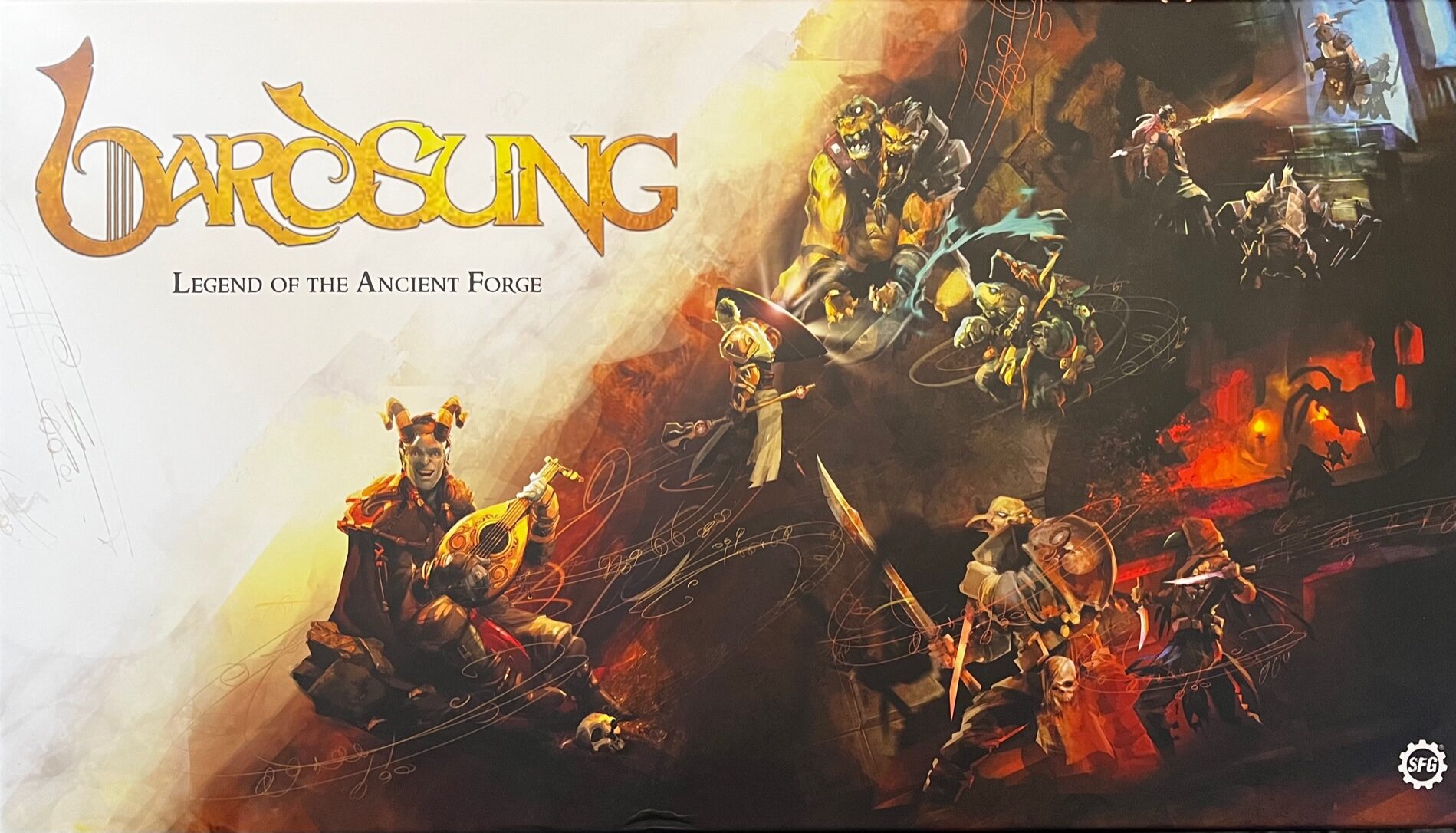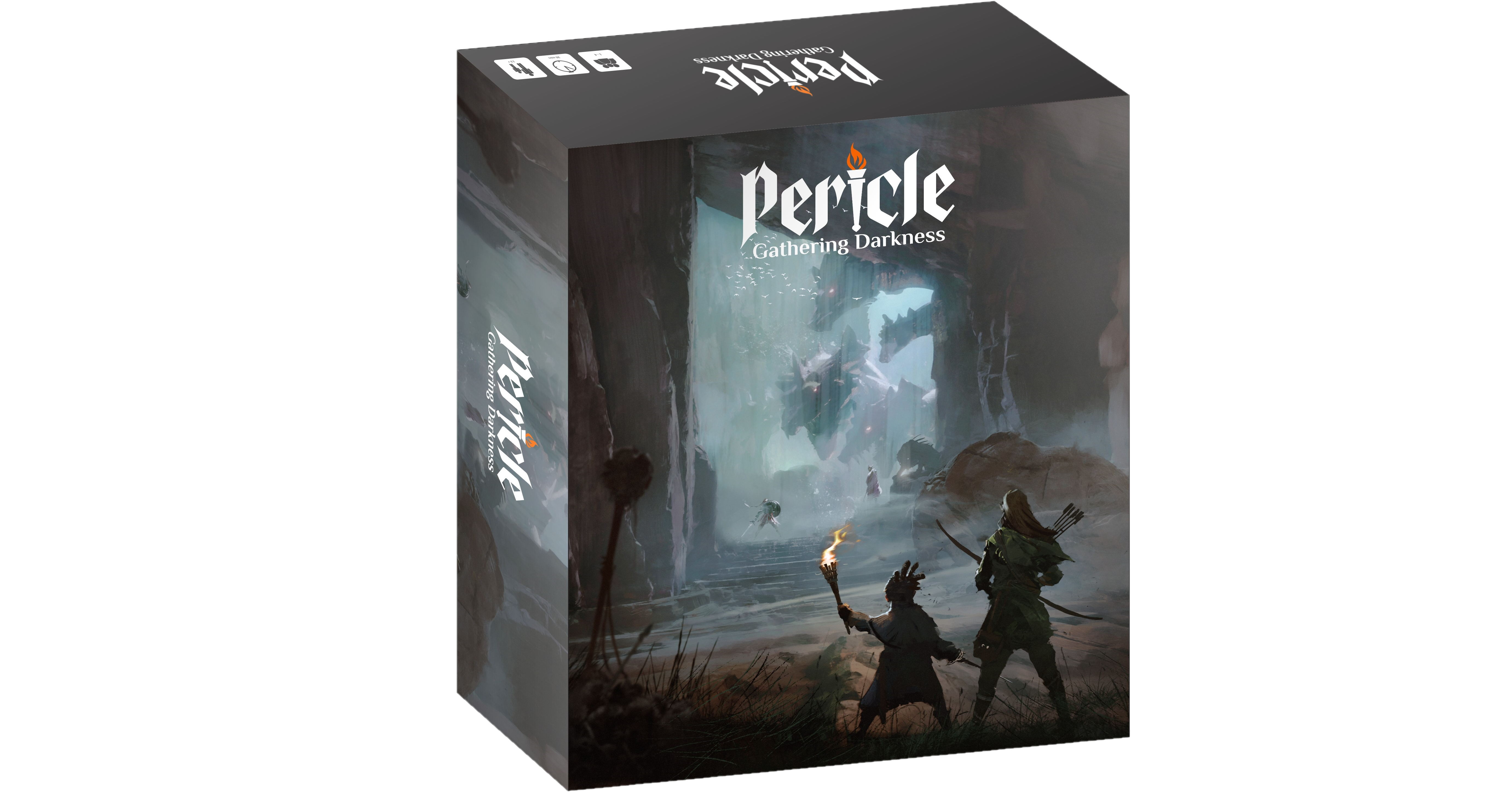Let’s discover a captivating world and engaging game play in the Bardsung Board Game Review.
I circled Bardsung for several months, watching the price on Amazon. It was already way past crowdfunding and in retail when I found out about it and the reviews that I was seeing on YouTube were not stellar. However, this game looked right up my alley. Narrative, branching storyline, random dungeons, cool minis, and lots of secrets to discover all called to me. I will say that it was good that I waited and spent some time with other games first, but I will ultimately say that I love this game.
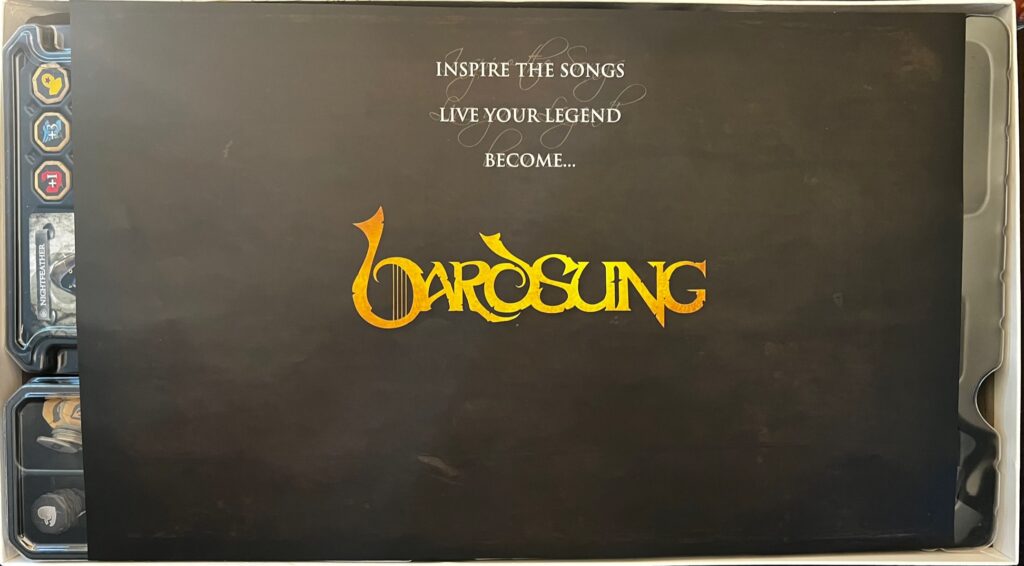
Overview
Bardsung is full of interesting mechanics, plenty of Oh Sh!t moments, and character customization that goes beyond what you would expect with pregenerated characters with skill cards. Yeah, it has some issues. Learning the game is way harder than it needs to be as the rule book really could have used more testing and editing. The game itself is rather easy to learn. A lot of the components are really great. If you’ve read anything about Bardsung however, you know that the big play board is not the best quality and is probably too big for pretty much everyone. I get why they wanted it, and we will talk about it, but some changes likely should have been made.
Game Play
Starting out with the game Play, it’s really pretty quick and simple. You’re basically looking at a D20 system. You have all of the normal attributes but they’re expressed as symbols rather than named. Actions that required a test will use a D20 roll with the required attribute added to try to overcome a TN (target number). Meet it or beat it and you have succeeded. Fall short and you miss or suffer the consequences. Damage is determined by your characters set damage die and you will be looking to overcome an enemy’s grit to deal a critical, which will allow you to deal maximum damage for an attack. Without the critical, there is still an effect but they won’t always deal damage. Attacks come in the form of skill cards. I like this idea as it makes each attack more interesting than simply “I whack it with my mace.” These will add different effects such as the ability to move after the attack is resolved, adding a status effect in addition to damage, or pushing an enemy. One of the funnest parts of this system is the ability to spend xp to gain skill cards from other characters. This allows for interesting customization as you can now add magic, charge attacks, or dexterity based skills to any character that you want to play. The majority of your action rolls and skills will correspond to combat but there is an occasional instance where an event card will require dexterity to dodge a trap, constitution to withstand a disease, or charisma to keep a crazy person from stabbing you.
Dungeon Generation and Narrative
Dungeon generation and exploration involve drawing room or corridor cards, finding the corresponding tile, and then either populating with the enemies that you will be facing or drawing from the Aspect Challenge Deck and resolving the challenge there. There is also a Aspect Battle Deck that will add new modifiers to each combat encounter. These two Aspect Decks help drive the narrative along with the campaign book. These decks are numbered on the back and as you move through the campaign book, you will be directed to remove and add cards to the deck that you draw from in exploration. A lot of times these are non-unique situations that you may encounter such as poison gas in the room that requires an action roll. However, sometimes they are more narratively based and will lead to decisions, finding cards in the narrative deck, and replacing cards in the Challenge or Battle Decks, or reading a narrative section from the campaign book. It’s an interesting system since it randomizes events throughout your exploration and may mean that you never draw a card that was in the deck as it gets removed in the next chapter. It’s a good idea and I have enjoyed seeing what would come up. It can be a little awkward but there’s only an extensive change whenever you begin a new chapter and once you become accustomed to it, it’s not a time consuming activity.
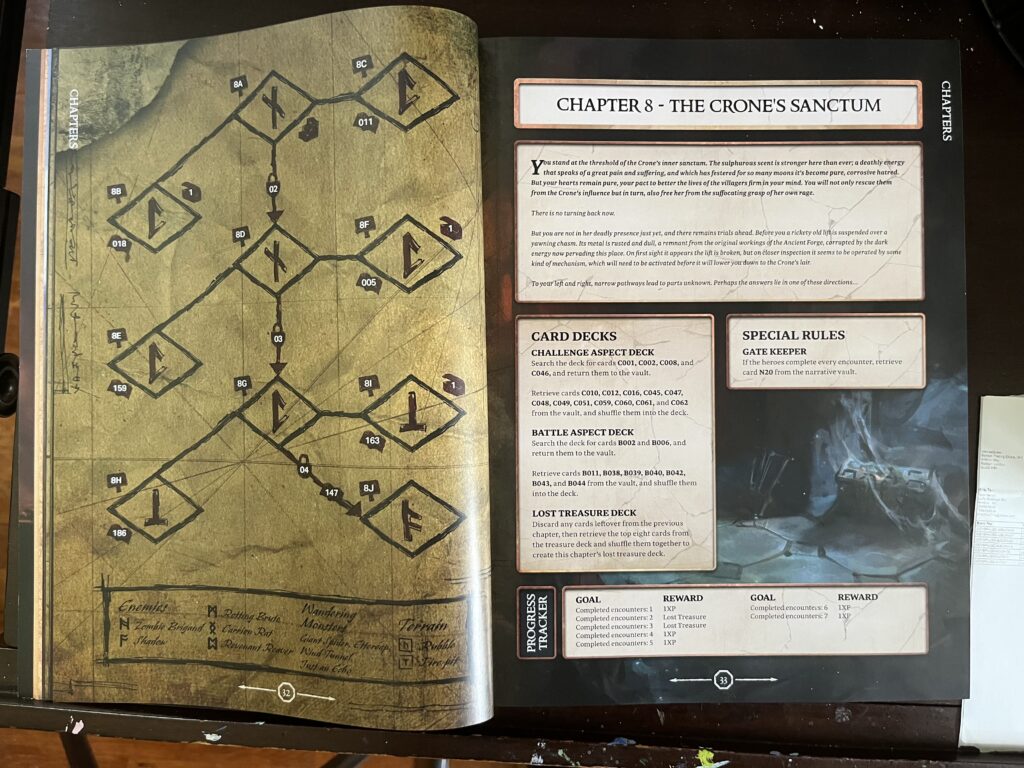
Combat
Combat tends to be well balanced although we have come across a couple of rooms that we simply decided the spend the actions to back out and close the door since enemies cannot open doors. The XP system is a little odd in that you receive XP from finishing Encounters (dungeons) or other chapter tasks rather than through any battle. As such, battles apart from boss battles are fairly optional. You would probably have a hard time getting through any of the dungeons without fighting anything but it’s possible and you would still gain the XP needed to buy new abilities and upgrades. Money would be what you generally missed out on though. The challenges give you a little, but most of your money comes from defeating monsters. Money can be used to purchase new items but rather to replenish tokens that you will use through the adventures.
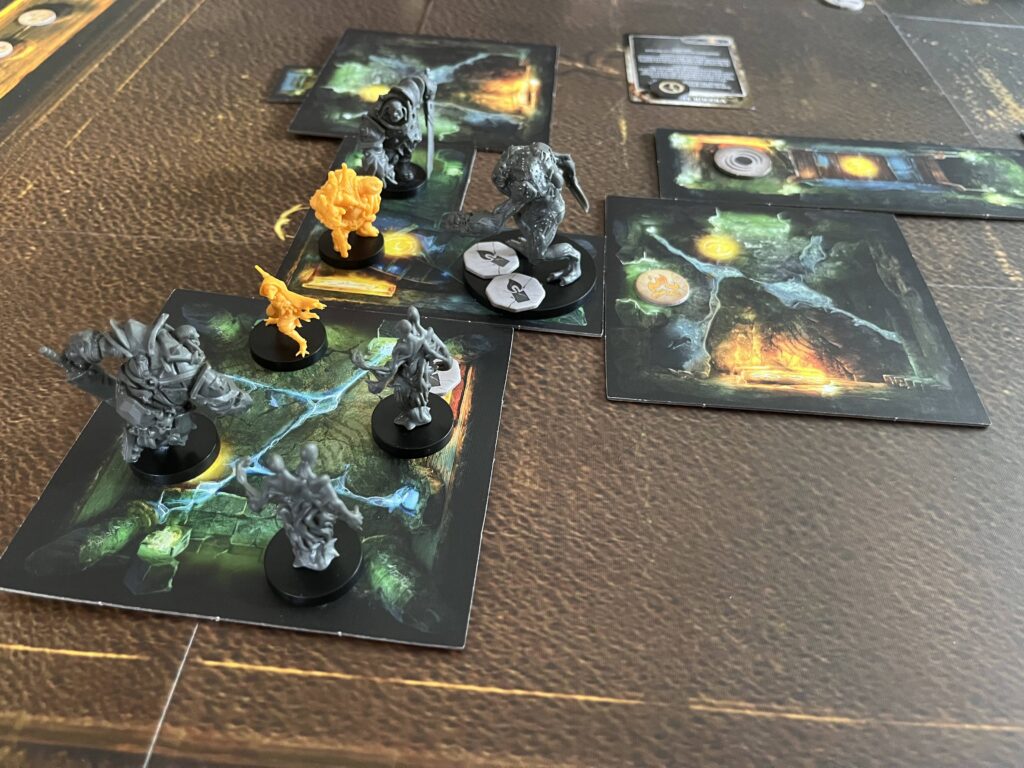
Essential Mechanics
There are five different tokens that can and should be utilized during the game. Fate tokens are used to add a bonus die to your attack rolls as well as being used to activate some abilities. Each character has certain actions and conditions that will replenish Fate tokens during play and while it is a resource that takes a little planning to manage, we have not generally had issues with running low on Fate. Sigils can be used to replenish all the Fate tokens at once. Perhaps as we continue with the game we will end up with turns that utilize enough Fate in one go that we will need these to do everything that we want to do, but thus far we have not had to use any of these. Campfires allow your party to rest, healing one life and removing any negative conditions. They also create a save point so that if someone in the party is defeated, the party will return to the campfire fully healed and the dungeon generated after the campfire will be removed. I like this mechanic and we have had to use it on occasion. The token is consumed once it is used as a save point like this, however. Toolkit tokens allow you to open up a hidden door, effectively changing the layout of the dungeon. And finally, there are health potions that can be used if a hero were going to be knocked out or otherwise in order to heal all wounds and remove all conditions. Each of the tokens will cost a bit of your hard-earned coin to replenish once used.
Loot
Loot is not too much of a consideration in this game. There is a treasure deck, but your weapons and armor are bespoke from the beginning of the game depending on your character. You receive new versions through the narrative or at milestones in the missions. When you receive treasure, it will be in the form of runes, gemstones, or kind of random items. The runes can be attached to armor, the gemstones to weapons. They will offer bonuses to things like defense or damage. The random items are a bit weird. I received a “Knuckle Bookmark” that allowed me to automatically pass any skill check. It was fine. I used it. In some ways the items and treasure feel a bit like the items from Gloomhaven JotL, a little tacked on and awkward. I’m not saying they’re not useful, but they’re not quite as coveted as a new weapon or magic item would be so on the encounters that have treasure, there’s less enthusiasm than might otherwise be expected.
Components
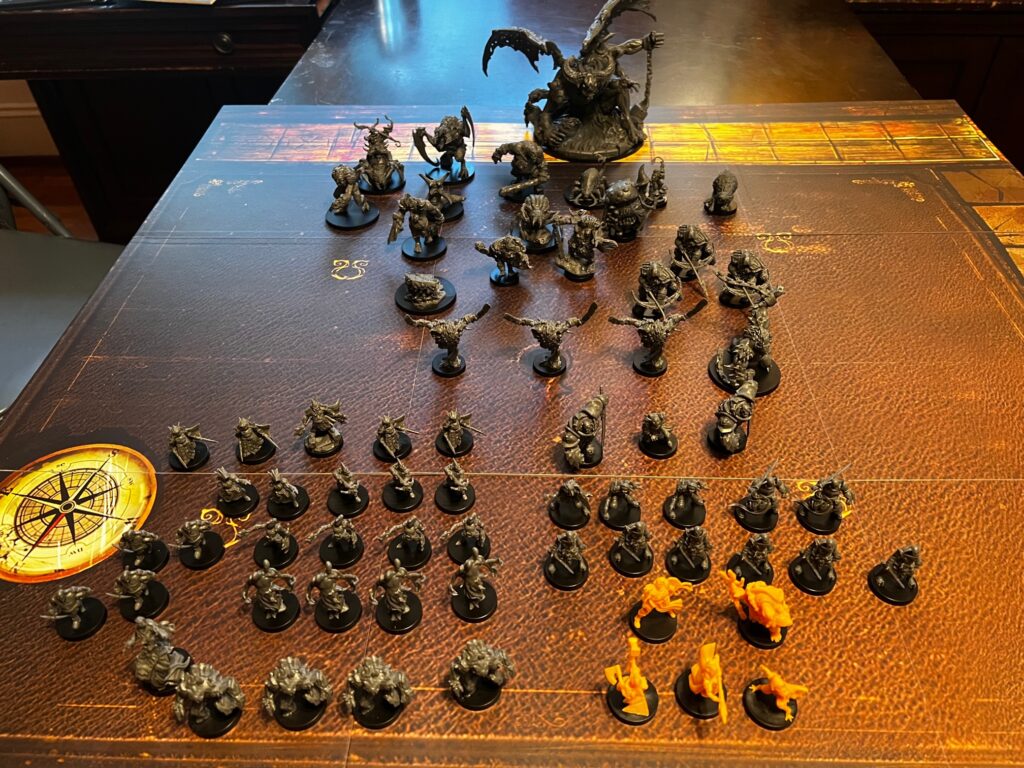
The components are mostly fantastic. The minis are great with good detail, except that they used yellow plastic for the hero minis. It does indeed make them stand out but it also makes it hard to see the details on the heroes and is generally not very visually appealing. The cards are of good quality and there are a lot of them, both poker sized and miniature. The art on the cards for the monsters is good and, although you will be using the same models for similar monsters, the cards do give variation to the monsters so you’re not fighting the same hobgoblin brute every time but maybe a zombie version etc. The dungeon tiles are pretty good. Rather than using a square or hex grid to mark spacing, the tiles use a zone system which is intended to be communicated through the tile art. Some tiles are easier to parse than others. The designers did apparently recognize this as a potential problem and included a cheat sheet on the back of the welcome sheet at the top of the box so that it could easily be seen how many zones and where fit on each tile.
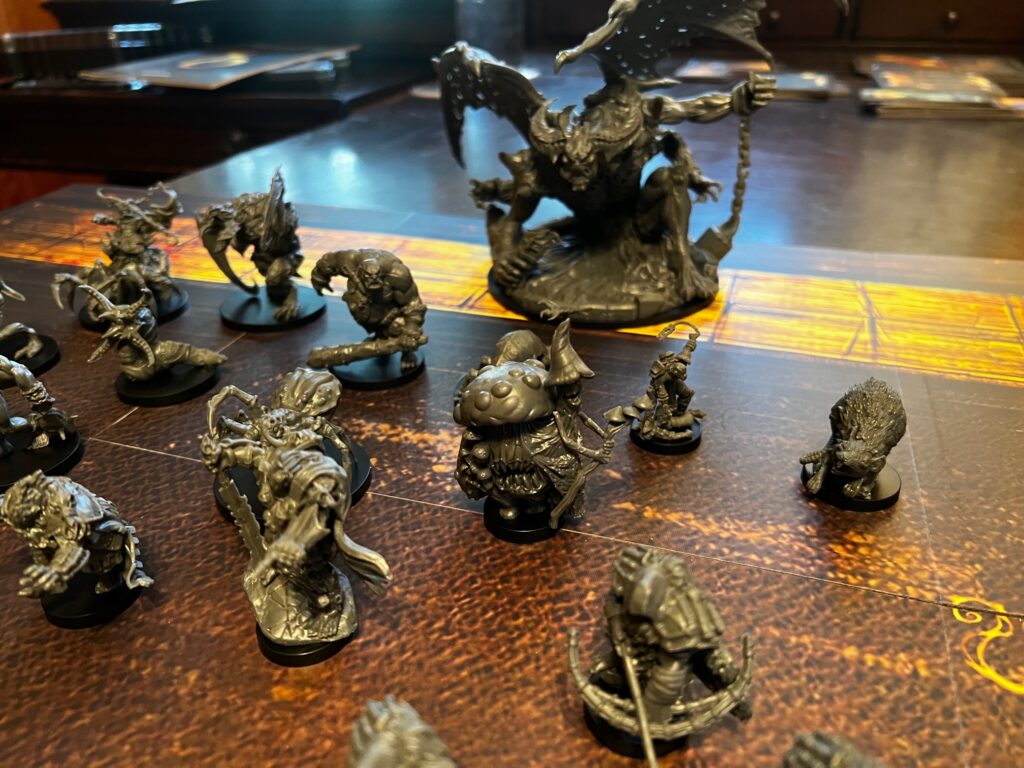
The Main Game Board
The included play board is really the only component that I think really needed more consideration. It really is huge and takes up a lot of space. In fact, it hangs off of each side of our tables by about an inch (need measurements). Besides hogging up a huge amount of table space (not necessarily a problem), the huge size of the board has affected its quality. Rather than have multiple boards, or preferably a playmat, SFG elected to make one single board with nine folding sections. It fits in the box fine but the weight of it and the awkwardness make it feel like the board will tear as you’re unfolding it. Further, warpage is evident on pretty much every section causing the board to not lay flat when unfolded. And finally, there is separation of the cardboard layers. All that said, once it’s out and you’re playing on top of it, you can get past it. I feel that there is a bit of wasted space on the board to it could have been made a bit smaller. It does serve a purpose in limiting the size of the dungeons, providing an initiative track, and providing space for the various consumable tokens. It doesn’t break the game for us, but we’ve spent a lot of time thinking about it could have been done better.
The Storage
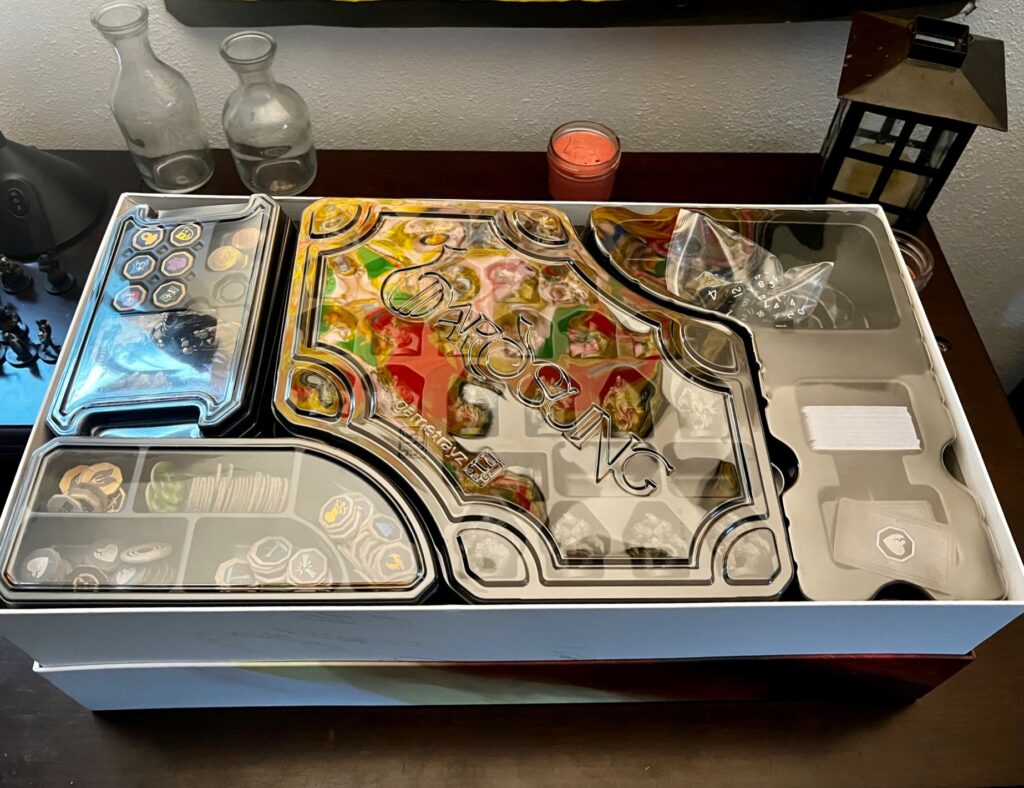
I think the best component, maybe even better than the minis… maybe, are the game trays and packaging. You’ll understand when you open the box. It’s really a pleasure. All of the trays were specially designed and fit together wonderfully, holding each component perfectly with each tray having its own spot in the box. The game is easy to pack up and with the storage ease, saving your place is almost as simple as hitting F5. Each player gets their own character tray that will hold stat tokens, skill cards, item cards, and XP tokens so that nothing gets lost in the box. The storage directly competes with the minis for the most impressive component of the game. Given the thoughtful nature of all of the trays, saving your game is a breeze with all of the character components fitting neatly into separate containers and leaving only a bookmark and keeping the cards separate. There are spaces in the trays for that too.
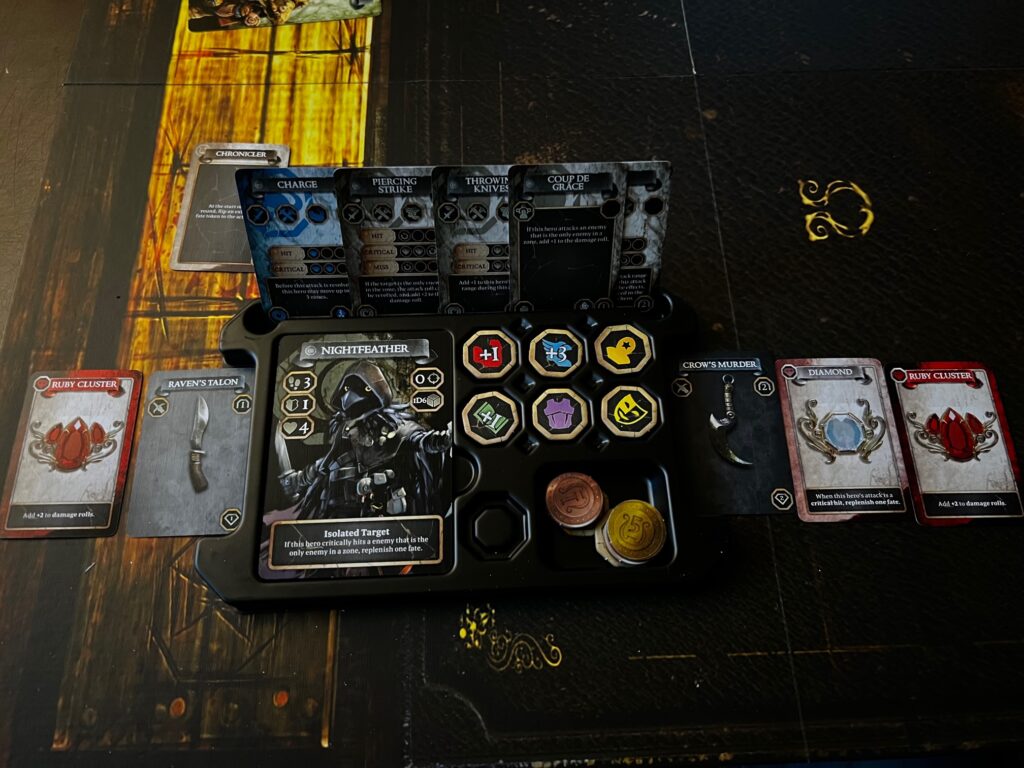
Solo / Co-op
Bardsung is a co-op only game. There is no competitive mode. Solo play is possible but still requires playing with two characters. There are a handful of sidekick type characters, but they mostly give benefits rather than being directly useful in a fight. The characters are simple enough that running them two fisted shouldn’t be too hard but for those that are seeking a true solo experience, you will need to do some tweaking and house ruling. The asymmetrical nature of the characters will also make true solo a little harder although it’s already possible to take other characters’ skills as your own so you should be able to build something that is reasonably balanced without too much effort.
Beyond the Game
So what else can you do with this game? The miniatures and dice are directly useful in most other fantasy games. Most of the monsters are fairly standard, although the minis are detailed and well-sculpted, and could be found in most games of DnD or other fantasy TTRPG’s. The lack of square or hex gridding on the dungeon tiles means that crunchier games won’t be able to use them without some fudging but games like Shadowdark or Index Card Rpg that use the looser Near, Close, and Far system would be able to make good use of them. The hero miniatures may be a little hard to fit into your campaign depending on what sort of world you’re playing in, whether or not you have turtle and bird people, and if you have the time to paint them. Some of the tokens could be useful and the hero boards with their stat tokens would fit pretty well in most OSR games that wouldn’t require you to track skills. Most of the cards and the adventure book won’t really be useful for much of anything else though as it’s a fairly self-contained system that curates the event cards based on where you are in the adventure book. This means that you will likely run into some strange and dissonant moments if you tried to use them as random encounter cards.
Rating 7.5
Overall, I would rate this game as a 7.5. I really do like it but I had to work harder than it felt like I should have to get there. The experience of opening the box and pulling the components was great but the game intro suffered once we started delving into the rulebook to learn how to play. After some stop-and-go accompanied by lots of page flipping, we finally found our rhythm and felt like we knew how to proceed with the game. If the game weren’t as simple as it is, we likely would have felt very frustrated. As it was, we had some laughs and were able to persevere. The dungeons are quick but numerous. I have heard some complain about it feeling grindy, but really this is just playing the game. There are often narrative passages between the individual dungeon nodes and narrative moments are also tucked into the Aspect Decks to be discovered at random. Leveling is on a fairly slow and even time frame so you may not be upgrading every play session, especially if you’re saving up for something substantial. It’s not as slow as a TTRPG though and you should be able to spend your XP at least every other session if not a little faster.
Who Should Get It?
I would suggest this to someone that is looking for a dungeon crawler with depth but that is not overly complicated. Yes, the rulebook can make it feel overly complicated when you’re reading through it, but once you’ve spent some time actually playing, you will see that it goes fairly quickly. There are also a few fan-made rulebooks out there that can really help clear things up. You can find these on Board Game Geek and elsewhere. Once learned, this game is easy to pick up and put down with a reasonable amount of set up time due to the game trays holding your components where you need them. Saving your game only requires putting the lid on your character tray, bookmarking the adventure book, and placing your Aspect Decks into the available compartments. The narrative is not excessive but does not feel revolutionary either. Altogether, it’s a fun time that is worth checking out, both for the game as designed as well as for the components included.
If you’re interested in picking Bardsung up, you can find it on Amazon or on the Steamforged website where you can also find the expansions.
